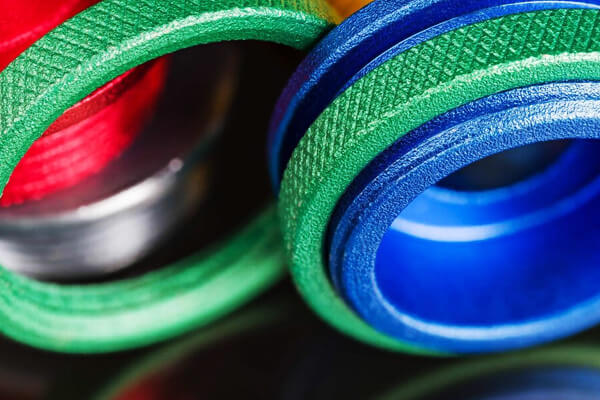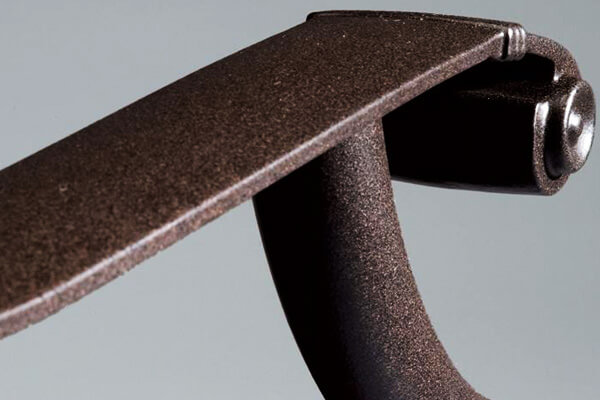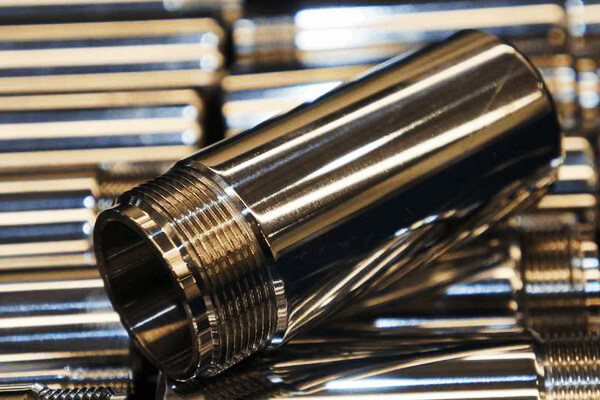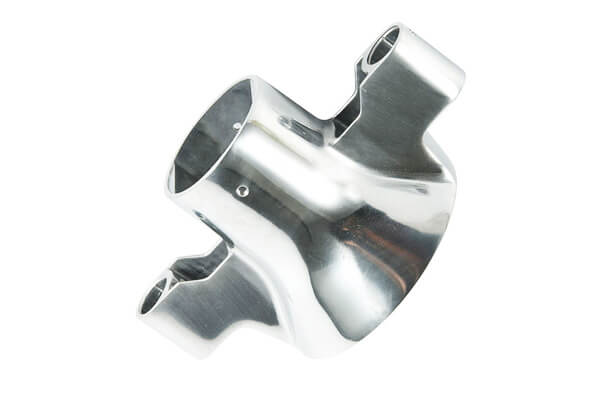Goss Aluminiumfinishen Deeler si wesentlech fir hir Erscheinung ze verbesseren, schützt se vu Korrosioun, a verbesseren hir funktionell Eegeschaften.
Verschidde Finishingsoptioune si verfügbar, all bitt eenzegaarteg Virdeeler a Charakteristiken.
Hei ass eng ëmfaassend Iwwersiicht iwwer déi meescht üblech Finishen fir Aluminiumgussdeeler, beräichert mat Daten a méi glatter Iwwergäng:
1. Anodiséieren
- Broessdatsch: Anodiséieren ass en elektrochemesche Prozess deen eng Schutzoxidschicht op der Aluminiumfläch opbaut, mécht et méi schwéier, méi haltbar, a resistent géint corrosion.
Déi anodiséiert Schicht kann och fir Faarf gefierft ginn, eng breet Palette ubidden.

- Ausgesinn: Kann kloer oder faarweg sinn (Z.B., schwaarz, Gold, rout).
- D'Applikatioun: Vill am Automotive benotzt, Aerospace, a Konsumentelektronik.
- Virdeeler:
-
- Korrosioun Resistenz: Anodiséieren verbessert d'Korrosiounsbeständegkeet wesentlech, mécht et ideal fir Outdoor a Marine Uwendungen.
- Haltbarkeet: Et schaaft eng schwéier, verschleißbeständeg Uewerfläch déi haart Ëmfeld widderstoen kann.
- Ästhetesch Appel: Anodiséierter Deeler kënne faarweg sinn, bitt eng Rei vun ästheteschen Optiounen.
- Nodeeler:
-
- Käschte: Anodiséieren ka méi deier sinn wéi aner Finishen wéinst der spezialiséierter Ausrüstung a Prozesser déi involvéiert sinn.
- Décker: Déi anodiséierter Schicht kann d'Dicke addéieren, déi knapp Toleranzen beaflosse kënnen.
- Daten: Anodiséierte Schichten kënne variéieren vun 0.5 zu 25 Mikron déck, jee no der Applikatioun. Zum Beispill, Typ II anodizing typesch rangéiert vun 5 zu 25 Mikord-Miconer, während Typ III (schwéier Mantel) kann bis erreechen 50 Mikord-Miconer.
2. Pudder Beschichtung
- Broessdatsch: Pulverbeschichtung beinhalt d'Uwendung vun engem dréchene Pudder (besteet aus Pigmenter a Harze) zum Aluminiumdeel, benotzt eng elektrostatesch Ladung fir d'Adherenz ze garantéieren.
Eemol beschichtet, deen Deel mécht en Aushärtprozess an engem Héichtemperaturofen, déi de Pulver zu engem elastesche bindt, eenheetlech Layer.

- Ausgesinn: Sinn an enger grousser Palette vu Faarwen an Texturen (Z.B., méiacht, glanz, texturéiert).
- D'Applikatioun: Allgemeng benotzt am Auto, Baulibatiounen, A Miwwel.
- Virdeeler:
-
- Haltbarkeet: Pulverbeschichtung bitt exzellente Resistenz géint Chipping, kraazt, an UV Degradatioun, mécht et ideal fir Outdoor benotzen.
- Ästhetesch Appel: Et bitt eng breet Palette vu Faarf- an Texturoptiounen, erlaabt kreativ a funktionell Designen.
- Ëmweltfrëndlechkeet: Pulverbeschichtung produzéiert manner flüchteg organesch Verbindungen (Vocos) am Verglach zu flëssege Faarwen, mécht et eng méi ëmweltfrëndlech Optioun.
- Nodeeler:
-
- Käschte: Et kann méi deier sinn wéi e puer aner Finishen wéinst der Bedierfnes fir spezialiséiert Ausrüstung.
- Curing Zäit: Den Aushärungsprozess füügt d'Produktiounszäit un, wat d'Leadzäiten beaflosse kann.
- Daten: Pudderbeschichtungen kënnen an Dicken applizéiert ginn, rangéiert vun 50 zu 150 Mikord-Miconer, suergt fir e robusten a laang dauerhafte Finish.
3. Mol méi faarten
- Broessdatsch: D'Aluminium ze molen beinhalt d'Applikatioun vu Schichten vu flëssege Faarwen, dacks mat enger Primerbasis fir d'Haftung ze verbesseren.
Fortgeschratt Spraytechniken kreéieren eng eenheetlech Schicht, an Ofschloss reegelméisseg vu matte bis héichglänzend.

- Ausgesinn: Sinn an enger grousser Palette vu Faarwen a Finishen (Z.B., glanz, semi-glanz, méiacht).
- D'Applikatioun: Allgemeng benotzt am Auto, Konsumente Fall, an architektonesche Uwendungen.
- Virdeeler:
-
- Ästhetesch Appel: Painting bitt eng breet Palette vu Faarwen a Finishen, mécht et héich versatile fir verschidden Uwendungen.
- Flexibilitéit: Et kann op komplex Geometrien a grouss Deeler applizéiert ginn, mécht et gëeegent fir eng Vielfalt vun Designen.
- Nodeeler:
-
- Haltbarkeet: Lack ass allgemeng manner haltbar wéi Pulverbeschichtung an Anodiséierung, mécht et méi ufälleg fir Chipping a Fading.
- Ëmwelt Impakt: Flësseg Faarwen kënne flüchteg organesch Verbindungen entloossen (Vocos) während Applikatioun, déi fir d'Ëmwelt schiedlech kënne sinn.
- Daten: Lackdicke kann variéieren, mee typesch Uwendungen Gamme vun 20 zu 50 Mikord-Miconer, ofhängeg vun der Faarfart an dem gewënschten Finish.
4. Elektroplating
- Broessdatsch: Electroplating involvéiert den Aluminiumdeel an enger Léisung mat opgeléisten Metallionen ënnerzegoen an dann en elektresche Stroum opzebréngen fir eng dënn Metallschicht ze deposéieren (wéi Nickel, Chrome, oder Kupfer) op d'Uewerfläch.

- Ausgesinn: Kann Chrom sinn, Nickel, zinc, oder aner Metaller.
- D'Applikatioun: Allgemeng benotzt am Auto, Elektronik, an dekorativen Uwendungen.
- Virdeeler:
-
- Korrosioun Resistenz: Electroplating verbessert d'Resistenz géint Korrosioun a Verschleiung, mécht et gëeegent fir Deeler ausgesat ze haarden Ëmfeld.
- Ästhetesch Appel: Et kann e glänzend ginn, reflektiv Finish, verbessert de visuellen Appel vum Deel.
- Nodeeler:
-
- Käschte: Electroplating kann méi deier sinn wéinst der Benotzung vun Edelmetaller an de Besoin fir spezialiséiert Ausrüstung.
- Ëmwelt Impakt: De Prozess kann geféierlech Chemikalien involvéieren an erfuerdert eng korrekt Entsuergung an Handhabung.
- Daten: Elektroplatéiert Schichten kënne variéieren vun 0.1 zu 50 Mikron déck, jee no der Applikatioun. Zum Beispill, Verchromung rangéiert typesch vun 0.1 zu 1 Mikron, iwwerdeems Zénk plating kann bis 25 Mikron déck.
5. Chemesch Konversioun Coatings (Alodin / Chromate Konversioun)
- Broessdatsch: E chemesche Prozess deen e Schutzfilm op der Uewerfläch vum Aluminium bildt.

- Ausgesinn: Typesch kloer oder iriséierend.
- D'Applikatioun: Allgemeng benotzt a Raumfaart a militäresch Uwendungen.
- Virdeeler:
-
- Korrosioun Resistenz: Chemesch Konversiounsbeschichtungen bidden e gudde Schutz géint Korrosioun, sou datt se ideal sinn fir Deeler déi u Feuchtigkeit a Chemikalien ausgesat sinn.
- Heshesioun: Si verbesseren Adhäsioun fir spéider Molerei oder Beschichtung, garantéiert e méi haltbaren Finish.
- Nodeeler:
-
- Ästhetesch Aschränkungen: Dës Beschichtungen si limitéiert op kloer oder iriséierend Finishen, déi vläicht net all ästheteschen Ufuerderunge treffen.
- Ëmwelt Impakt: E puer Chromatléisungen si gëfteg a erfuerderen virsiichteg Handhabung an Entsuergung.
- Daten: Chemesch Konversiounsbeschichtungen sinn typesch 0.1 zu 1 Mikron déck, bitt eng dënn awer effektiv Schutzschicht.
6. Poléieren an Buffing
- Broessdatsch: Poléieren implizéiert d'Aluminiumfläch mechanesch oder mat spezielle Poliermëttel ze buffen fir en Héichglanz ze kreéieren, reflektiv Uewerfläch.
Poléieren kann duerch Versiegelung gefollegt ginn fir de reflektive Finish ze schützen.

- Ausgesinn: Kann en Héichglanz erreechen, Spigel-ähnlech fäerdeg.
- D'Applikatioun: Allgemeng an dekorativen an héich-Enn Uwendungen benotzt.
- Virdeeler:
-
- Ästhetesch Appel: Poléieren a Buffing suerge fir en Héichglanz, poléiert Look, verbessert de visuellen Appel vum Deel.
- Haltbarkeet: Dës Prozesser verbesseren der Uewerfläch hardness an Resistenz zu kraazt, mécht den Deel méi haltbar.
- Nodeeler:
-
- Aarbechtsintensiv: Polieren a Buffing erfuerdert manuell Aarbecht a kann Zäitopwänneg sinn, d'Erhéijung vun der Produktiounskäschte.
- Käschte: Déi Aarbechtsintensiv Natur vun dëse Prozesser kann se méi deier maachen wéi aner Ofschlossoptiounen.
- Daten: Poléiert Flächen kënnen eng Uewerflächrauhegkeet vu manner wéi erreechen 0.1 Mikord-Miconer, bitt e glatten a reflektive Finish.
7. Sandblasting
- Broessdatsch: E Prozess wou abrasiv Medien op d'Uewerfläch vum Deel geplatzt ginn fir eng Uniform ze kreéieren, texturéierte Finish.
- Ausgesinn: Kann e matte oder satinfinish erreechen.
- D'Applikatioun: Allgemeng benotzt am Auto, industriell, an architektonesche Uwendungen.
- Virdeeler:
-
- Ästhetesch Appel: Sandblasting gëtt eng Uniform, texturéierte Finish, gëtt dem Deel en eenzegaartegen an attraktiven Erscheinungsbild.
- Virbereedung: Et kann d'Uewerfläch fir eng spéider Beschichtung oder Molerei virbereeden, Verbesserung vun der Adhäsioun an der Haltbarkeet.
- Nodeeler:
-
- Uewerfläch Rauh: Sandblasting kann d'Uewerflächrauhegkeet erhéijen, déi fit a Funktioun Afloss kann.
- Ëmwelt Impakt: De Prozess erfuerdert eng korrekt Entsuergung vu abrasive Medien fir den Ëmweltimpakt ze minimiséieren.
- Daten: Sandblasted Fläch kann eng Uewerfläch roughness vun erreechen 1 zu 5 Mikord-Miconer, eng konsequent a kontrolléiert Textur ubidden.
8. Mechanesch Pinselen
- Broessdatsch: Pinselen Aluminium schaaft eng z'ënnerscheedde, Direktiounskorn andeems Dir et mat Schleifpads oder Pinselen reift.
Dëse Finish verstoppt kleng Mängel wärend e modernen, stylesch Bléck. - Ausgesinn: Kann e gebastelten oder satinfinish erreechen.
- D'Applikatioun: Allgemeng benotzt an der architektonescher, Automotiv, a Konsumgidder.
- Virdeeler:
-
- Ästhetesch Appel: Mechanesch Pinselen gëtt eng Uniform, Richtungsfinanz, verbessert de visuellen Appel vum Deel.
- Virbereedung: Et kann d'Uewerfläch fir eng spéider Beschichtung oder Molerei virbereeden, Verbesserung vun der Adhäsioun an der Haltbarkeet.
- Nodeeler:
-
- Uewerfläch Rauh: Mechanesch Pinselen kënnen d'Uewerflächrauhegkeet erhéijen, déi fit a Funktioun Afloss kann.
- Aarbechtsintensiv: De Prozess erfuerdert manuell Aarbecht a kann Zäitopwänneg sinn, d'Erhéijung vun der Produktiounskäschte.
- Daten: Mechanesch gekämmt Fläch kann eng Uewerfläch roughness vun erreechen 0.5 zu 2 Mikord-Miconer, suergt fir eng glat a konsequent Finish.
9. Keramik Beschichtung
- Prozess: Keramik Beschichtung beinhalt d'Applikatioun vun enger dënn Keramik-baséiert Léisung op d'Aluminium Uewerfläch. Wann geheelt, dëst Formen eng schwéier, Schutzschicht déi extrem Hëtztbeständeg an haltbar ass.
- Virdeeler: Keramik Beschichtungen si besonnesch resistent géint héich Temperaturen, mécht se gëeegent fir Deeler ausgesat ze Hëtzt. Dës Beschichtungen kënnen d'thermesch Resistenz duerch iwwer verbesseren 50%, mécht se populär an Hëtzt-intensiv Industrien. Keramik Beschichtungen verbesseren och d'Abrasiounsbeständegkeet, a verschidde Formuléierunge kënne bis zu 1000 ° F widderstoen (538° C).
- Uwendungen: Keramik-beschichtete Aluminium gëtt wäit benotzt an Automotiv (exhöséiert, Motor Komponente), Aerospace, an an Elektronik, wou héich thermesch Resistenz an Haltbarkeet néideg sinn.
10. Schoss Héichiewe
- Prozess: Shot Blasting ass eng Ofschlosstechnik déi d'Aluminiumfläch mat abrasive Materialien bombardéiert, wéi Stol Schoss oder Glaspärelen, eng Uniform ze kreéieren, texturéierte Finish.
- Virdeeler: Schéissbléisung ass kosteneffektiv fir Uewerflächepräparatioun a léisst eng matte Textur déi hëlleft d'Lack- oder Pulverbeschichtung Adhäsioun vu bis zu 20%. De Prozess stäerkt och d'Uewerfläch duerch e liichte Work-hardening Effekt.
- Uwendungen: Oft benotzt an Industriell Maschinnen, Automotive Komponenten, an an Bau Equipement, Schossgestrahlte Aluminiumflächen si geschätzt fir hir net reflektiv, texturéierte Finish.
Andeems Dir d'Charakteristiken an Uwendungen vun all Finish versteet, Dir kënnt déi bescht Optioun auswielen fir Är spezifesch Bedierfnesser ze treffen an héichqualitativ ze kreéieren, funktionell, an ästhetesch agreabel Goss Al Deeler.
Wann Dir all Goss Aluminiumveraarbechtungsbedürfnisser hutt, Fillt Iech gratis kontaktéiert eis.



